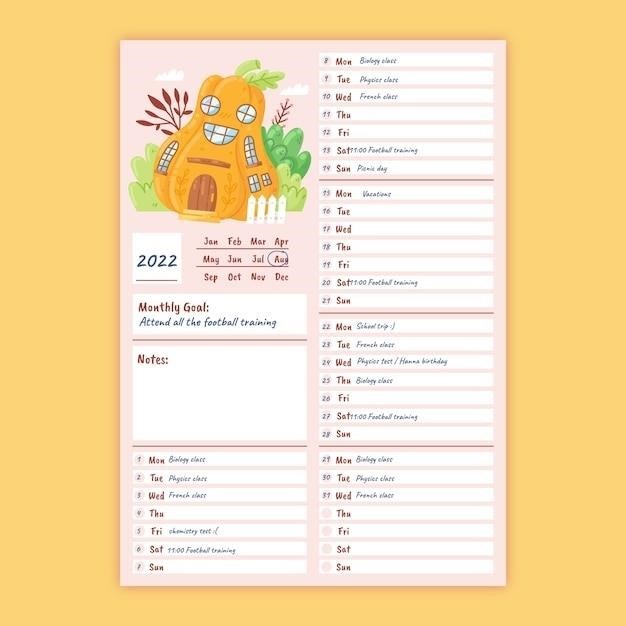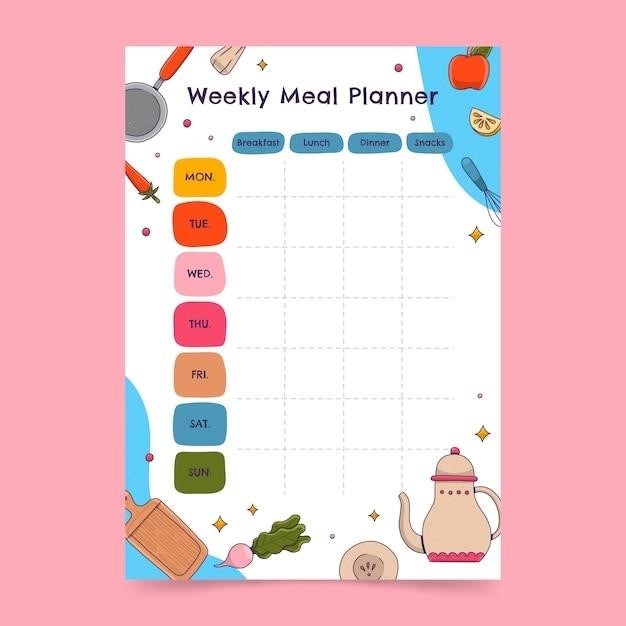Printable Preschool Daily Report PDFs⁚ A Comprehensive Guide
This guide explores the benefits‚ types‚ and creation of printable preschool daily report PDFs. Discover essential information to include‚ template selection tips‚ customization options‚ and free online resources. Learn how to effectively use free templates while addressing legal considerations.
Benefits of Using Printable Preschool Daily Reports
Printable preschool daily reports offer numerous advantages for both educators and parents. For educators‚ these reports streamline communication‚ providing a concise record of each child’s daily activities‚ behavior‚ and progress. This structured format ensures consistency and reduces the risk of overlooking key details. The ease of printing allows for quick distribution‚ saving valuable time compared to handwritten notes or lengthy email updates. Moreover‚ the visual nature of a printed report can be more engaging for parents‚ who can readily see their child’s accomplishments and areas needing attention. These reports foster a stronger parent-teacher connection‚ enhancing collaboration in supporting the child’s development.
From a parent’s perspective‚ printable daily reports offer a clear and readily accessible record of their child’s day. This transparency builds trust and allows parents to actively participate in their child’s learning journey. Parents can easily track their child’s progress in different areas‚ such as social interaction‚ academic activities‚ and emotional well-being. The daily updates also provide valuable insights into the child’s behavior‚ routines‚ and overall experience at preschool‚ facilitating better understanding and support at home. The printed format ensures easy storage and allows parents to review the reports at their convenience‚ creating a valuable keepsake to document their child’s early years.
Types of Printable Daily Reports Available
The variety of printable preschool daily report PDFs caters to diverse needs and preferences. Basic templates offer simple sections for recording a child’s name‚ date‚ meals‚ naps‚ and general notes on behavior and activities. More comprehensive reports incorporate detailed sections for tracking specific developmental milestones‚ such as potty training progress‚ language development‚ or social interactions. Some templates include checkboxes or rating scales for easy assessment of various aspects of a child’s day‚ such as mood‚ participation‚ and cooperation. Specialized templates exist for infants and toddlers‚ focusing on feeding‚ sleeping‚ and diaper changes‚ while preschool-aged children’s reports often include academic progress and classroom participation.
Furthermore‚ the design and layout of printable daily reports vary. Some are simple and straightforward‚ utilizing minimal space‚ while others incorporate visuals like colorful borders or images. The choice depends on the preschool’s branding and the specific information needed. Some templates are designed to print multiple reports per page to conserve paper‚ while others provide a single report per page for easier readability. The availability of different formats‚ such as PDF‚ Word‚ or even image files‚ allows for flexibility in printing and customization. Ultimately‚ the optimal type of printable daily report depends on the individual preschool’s requirements and the preferences of both educators and parents.
Key Information to Include in a Daily Report
A well-structured preschool daily report PDF should concisely yet comprehensively capture a child’s day. Essential elements include the child’s name and the date‚ ensuring clear identification and chronological tracking. Details about meals and snacks consumed are crucial for monitoring dietary intake and identifying potential allergies or preferences. Sleep patterns‚ including nap times and duration‚ provide insights into a child’s rest and overall well-being. Potty training progress‚ if applicable‚ is a valuable indicator of developmental milestones. Specific notes on activities and learning experiences throughout the day offer context for observed behaviors and achievements.
Beyond the basics‚ incorporating observations on a child’s mood‚ social interactions‚ and overall behavior provides a holistic picture. Note any significant events‚ such as accidents or illnesses‚ along with the actions taken. Specific details about participation in classroom activities‚ like circle time‚ free play‚ or structured learning sessions‚ offer valuable feedback on engagement and learning progress. Teachers may also include comments on specific skills demonstrated‚ challenges faced‚ or areas for improvement. For collaborative care‚ including notes on interactions with therapists or specialists‚ if any‚ ensures a cohesive approach to the child’s development. Remember‚ clear‚ concise language‚ and a focus on factual observations are crucial for effective communication with parents.
Choosing the Right Template for Your Needs
Selecting the optimal printable preschool daily report PDF template requires careful consideration of several factors. First‚ evaluate the layout and design; a clear‚ uncluttered format ensures readability and efficient data entry. Consider the amount of space allocated for different sections; sufficient room for detailed observations is vital‚ while excessive space might lead to unnecessary verbosity. The template’s overall aesthetic is also important; a visually appealing design can enhance parent engagement and create a positive impression. Think about the specific information you need to track; some templates prioritize behavioral observations‚ while others focus on academic progress or developmental milestones. Ensure the chosen template aligns with your specific reporting requirements.
Functionality is another key aspect; consider features like pre-filled sections for common entries‚ customizable fields for unique needs‚ and compatibility with various software and printing options. User-friendliness is paramount; a simple‚ intuitive design reduces administrative burden and minimizes errors; Prioritize templates that allow for easy data entry and modification‚ saving time and effort; If using a digital solution‚ ensure it integrates well with your existing systems. Finally‚ consider the long-term implications; choose a template that is easily adaptable to future changes in your reporting needs‚ ensuring sustained usability and efficiency.
Customizing Your Printable Daily Report
Once you’ve chosen a suitable template‚ customization is key to creating a truly effective preschool daily report. Begin by personalizing the header with your preschool’s logo and contact information‚ creating a professional and easily identifiable document. Tailor the sections to reflect your specific curriculum and assessment methods; include areas for noting participation in specific activities‚ progress on learning objectives‚ or observations of social-emotional development. Consider adding space for comments regarding individual children’s needs or achievements; this allows for more nuanced reporting beyond simple checkboxes or ratings. If using a digital template‚ explore options for adding images or graphics to enhance engagement; photos of children engaged in activities can personalize the report and make it more appealing to parents.
Furthermore‚ ensure the language used is clear‚ concise‚ and accessible to parents with varying levels of literacy. Avoid jargon or overly technical terms; use plain language that is easy to understand. Consider using a consistent color scheme and font for improved readability and visual appeal. If you’re incorporating ratings or scoring systems‚ clearly define the criteria for each level to ensure parents understand the assessment process. Regularly review and update your template; this ensures it remains relevant to your evolving curriculum and reporting needs. Remember‚ the goal is to create a report that is both informative and engaging‚ fostering positive communication between preschool and parents.

Finding Free Printable Daily Report Templates

Numerous online resources offer free printable preschool daily report templates. Carefully evaluate their quality and suitability before use‚ ensuring they meet your specific needs and legal requirements.
Online Resources for Free Templates
The internet provides a wealth of options for sourcing free printable preschool daily report templates. Websites specializing in educational resources‚ teacher communities‚ and even general template sites often host downloadable PDFs. These can range from basic formats with simple fields for recording daily activities and observations‚ to more sophisticated designs that incorporate sections for tracking specific developmental milestones or behavioral patterns. Some sites offer customizable templates‚ allowing you to adjust the layout‚ add your center’s logo‚ or modify the included fields to reflect your unique requirements. Remember to always preview the template before downloading to ensure it’s suitable for your needs. Additionally‚ be mindful of the file format; PDF is generally preferred for its print consistency and accessibility across different devices and operating systems. Always check the terms of use associated with any free template you download to ensure compliance with licensing agreements and avoid any potential copyright infringements. Thorough research and careful selection can lead you to a free template that effectively serves your communication needs with parents and guardians.
Evaluating the Quality of Free Templates
Before committing to a free printable preschool daily report template‚ careful evaluation is crucial. Begin by previewing the template thoroughly. Assess its readability; is the font size and style clear and easy to read? Does the layout present information logically and efficiently? Check for sufficient space for recording pertinent details. Consider the overall aesthetic appeal; a well-designed template can enhance professionalism. Examine the fields provided; do they align with your reporting needs? Are there options for tracking key developmental areas‚ meals‚ naps‚ and significant incidents? Download a sample to test the print quality. Does it print cleanly‚ without any distortion or blurring? Finally‚ investigate the source of the template. Is it from a reputable website or organization known for providing reliable educational resources? A template’s quality directly influences its usefulness. A well-designed‚ easy-to-use template streamlines your reporting process‚ ensuring clear and consistent communication with parents. Conversely‚ a poorly designed template can lead to confusion and frustration. Prioritize templates that are both functional and visually appealing.
Tips for Using Free Templates Effectively
Maximize the effectiveness of free printable preschool daily report PDFs with these strategies. First‚ personalize the template to reflect your preschool’s specific needs and branding. Add your logo‚ contact information‚ and any relevant school policies. Ensure consistent and legible handwriting or utilize a digital format that allows for easy typing. Maintain a clear‚ concise‚ and objective reporting style. Focus on factual observations rather than subjective opinions‚ and use precise language to describe behaviors and activities. Consider color-coding or using symbols to highlight key information‚ such as positive achievements or areas needing attention. For improved organization‚ create a filing system for the completed reports. This may involve a physical filing cabinet or a digital system for easy retrieval. Regularly review and update your template to ensure it continues to meet your needs. Adapt it as your curriculum changes or as your reporting requirements evolve. Finally‚ communicate clearly to parents how to interpret the information on the reports. Provide any necessary explanations or definitions to ensure a seamless understanding between the preschool and the parents.
Legal Considerations for Daily Reports
Preschool daily reports‚ even those seemingly innocuous‚ involve legal considerations. Ensure compliance with relevant data privacy regulations like FERPA (Family Educational Rights and Privacy Act) in the US or equivalent laws in your jurisdiction. These laws dictate how student information is handled‚ stored‚ and shared. Avoid including personally identifiable information (PII) beyond what’s strictly necessary. Sensitive information such as medical diagnoses or behavioral issues requires parental consent before inclusion. Maintain confidentiality; securely store physical and digital reports‚ limiting access to authorized personnel only. Document your consent process‚ including obtaining written permission from parents for specific data sharing. Consult with legal counsel to ensure your reporting practices align with all applicable laws and regulations. Regularly review and update your procedures to reflect changes in legislation or best practices. Consider using anonymized data for statistical analysis while safeguarding individual student information. Remember‚ legal compliance is paramount; non-compliance can lead to serious consequences. A well-defined policy and procedure on data handling will protect your preschool and the families you serve.
